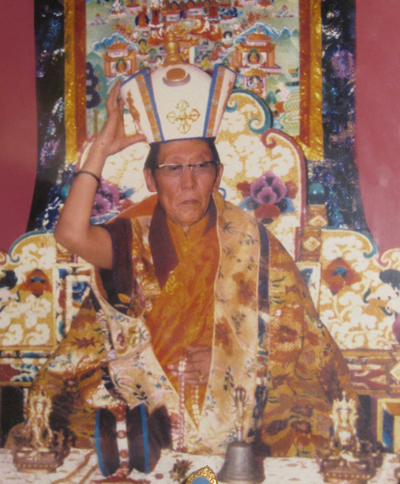From an interesting recent post of Himalayan Art Resources,
Many have heard of the famous black hat of the Karmapa and the red hat of the Shamarpa, maybe the lotus hat of Padmasambhava and the yellow hat of the Gelugpa Tradition. What about a white hat that is identical to the black hat of Gyalwa Karmapa?
In East Tibet there is a Kagyu Lama named Tsatsa Drubgon Rinpoche. He wears a white hat identical to the Karmapa black hat. This white hat according to the Tibetan biography of Tsatsa Rinpoche is said to have come about as a gift of the 8th Karmapa Mikyo Dorje. In his vision Karmapa saw that Tsatsa Rinpoche had four great characteristics: outer, inner, secret and very secret. The outer characteristic is that Karmapa saw Tsatsa as being very white, of a pure white colour – like the appearance of the goddess of wisdom and learning, Sarasvati. Another of the characteristics was that he embodied the Mahamudra – the highest philosophical view found in the new Tantras from India in the 11th century.
It would seem that it was the outer characteristic that led to the gift of the white hat given by the 8th Karmapa, of the Karma Kagyu Tradition, along with a seal that that has two different styles of lettering. The first with the letters in Tibetan script found in the four corners of the square seal reads Karma pa’i Tsatsa Lama. The central area of the seal in the shape of a cartoche atop a lotus with five visible petals is written in Pagpa’i Script and reads Tsatsa Lama.
Actually it is said that this Tsatasa was one of the principal students of the 7th Karmapa. Prior to that time the earliest documented pre-incarnation was a student of Pagmodrupa and Tstsa followed Pagdru Kagyu Tradition. After the time of the 8th Karmapa the Tsatsa Lamas became more closely assoiciated with the Karma Kagyu Tradition. The name tsatsa of Tsatsa Rinpoche occurred because at one time he spent time making many tsatsa offering molds of all types. When he made water tsatsa they would turn into crystal. After that he was known as Tsatsa Rinpoche.
Read the whole post here.

Thank you for subscribing to Tricycle! As a nonprofit, we depend on readers like you to keep Buddhist teachings and practices widely available.